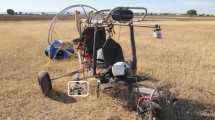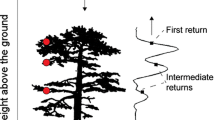Abstract
Improving trees location under LiDAR-derived digital canopy height models (DCMs) is of great interest as discrepancies between both dataset influence the accuracy of the estimations of forest attributes. A method is proposed for the co-registration of LiDAR-derived DCMs with local field positional measurements under a dense tree canopy. This approach consists of two main stages: (1) the assessment of the match between the LiDAR-derived digital terrain model and topographic surveying measurements when shifting the coordinates around a measured position; and (2) a comparison between the field height of selected trees and the LiDAR-derived DCM. Satisfactory results were obtained from geo-referencing field data and LiDAR models for characterizing the forest structure in heterogeneous Pinus sylvestris stands. Closure error of topographic surveying was 17.7 cm, and GPS accuracy to 95 % probability was below 10 cm, thus considerably lower than the resolution of the LiDAR models (1 m-pixel). The best co-location for field trees and LiDAR models provided a coefficient of determination of 0.56 between field-measured tree heights and LiDAR-derived DCM values.




Similar content being viewed by others
Notes
GPS devices can be classified into two groups depending on the observable used for ranging. These observables are the coarse/acquisition (C/A) code, normally used in relatively undemanding applications; and the carrier phase, employed for accurate positioning. In addition, two different processing modes can be applied: “single-point” positioning and “differential” positioning. Single-point positioning techniques involve only one autonomous receiver observing the C/A code. The differential processing mode requires a minimum of two nearby receivers observing either the C/A code or the carrier phase simultaneously. At least one receiver must be located in a known position (i.e. base receiver). The acquisition of simultaneous observations in different receivers permits the cancellation of error sources (differential correction) such as atmospheric delays or ephemeris, and clock errors that affect both receivers equally (Mauro et al. 2011).
References
Bitterlich W (1948) Die Winkelzahlprobe. Allgeni Forst und Holtz Zeit 59(i):4–5
Brandtberg T, Warner TA, Landenberger RE, McGraw JB (2003) Detection and analysis of individual leaf-off tree crowns in small footprint, high sampling density lidar data from the eastern deciduous forest in North America. Remote Sens Environ 85:290–303
Clark ML, Clark DB, Roberts DA (2004) Small-footprint lidar estimation of sub-canopy elevation and tree height in a tropical rain forest landscape. Remote Sens Environ 91:68–89
Dorigo W, Hollaus M, Wagner W, Schadauer K (2010) An application-oriented automated approach for co-registration of forest inventory and airborne laser scanning data. Int J Remote Sens 31:1133–1153
Frazer GW, Magnussen S, Wulder MA, Niemann KO (2011) Simulated impact of sample plot size and co-registration error on the accuracy and uncertainty of LiDAR-derived estimates of forest stand biomass. Remote Sens Environ 115:636–649
Gobakken T, Naesset E (2008) Assessing effects of laser point density, ground sampling intensity, and field sample plot size on biophysical stand properties derived from airborne laser scanner data. Can J For Res 38:1095–1109
Mauro F, Valbuena R, Manzanera JA, García-Abril A (2011) Influence of Global Navigation Satellite System errors in positioning inventory plots for tree height distribution studies. Can J For Res 41:11–23
Naesset E (1999) Point accuracy of combined pseudorange and carrier phase differential GPS under forest canopy. Can J For Res 29:547–553
Naesset E (2001) Effects of differential single- and dual-frequency GPS and GLONASS observations on point accuracy under forest canopies. Photogramm Eng Remote Sens 67:1021–1026
Naesset E (2002) Predicting forest stand characteristics with airborne scanning laser using a practical two-stage procedure and field data. Remote Sens Environ 80:88–99
Naesset E, Bjerke T, Bvstedal O, Ryan LH (2000) Contributions of differential GPS and GLONASS observations to point accuracy under forest canopies. Photogramm Eng Remote Sens 66:403–407
Olofsson K, Lindberg E, Holmgren J (2008) A method for linking field-surveyed and aerial-detected single trees using cross correlation of position images and the optimization of weighted tree list graphs. In: Hill RA, Rosette J, Suárez J (eds) Proceedings of SilviLaser 2008: 8th international conference on LiDAR applications in forest assessment and inventory. Edinburgh, UK, p 95–104
Pascual C, García-Abril A, García-Montero LG, Martín-Fernández S, Cohen WB (2008) Object-based semi-automatic approach for forest structure characterization using LiDAR data in heterogeneous Pinus sylvestris stands. For Ecol Manag 255:3677–3685
Persson A, Holmgren J, Söderman U (2002) Detecting and measuring individual trees using an airborne laser scanner. Photogramm Eng Remote Sens 68:925–932
Rodríguez-Pérez JR, Álvarez MF, Sanz-Ablanedo E (2007) Assessment of low-cost GPS receiver accuracy and precision in forest environments. J Surv Eng 133:159–167
Roupsard O, le Maire G, Nouvellon Y, Dauzat J, Jourdan C, Navarro M, Bonnefond J, Saint-André L, Mialet-Serra I, Hamel O, Rouzière A, Bouillet J (2009) Scaling-up productivity (NPP) using light or water use efficiencies (LUE, WUE) from a two-layer tropical plantation. Agrofor Syst 76:409–422
Sigrist P, Coppin P, Hermy M (1999) Impact of forest canopy on quality and accuracy of GPS measurements. Int J Remote Sens 20:3595–3610
Wang H, Weinacker H, Koch B (2008) A Lidar point cloud based procedure for vertical canopy structure analysis and 3D single tree modelling in forest. Sensors 8:3938–3951
Acknowledgments
Financial support for the study was provided by the Madrid Education and Culture Council through Project GR/AMB/0267/2009, and by the Technical University of Madrid (UPM) through Project N8 CCG07-UPM/AMB-2056.
Author information
Authors and Affiliations
Corresponding author
Rights and permissions
About this article
Cite this article
Pascual, C., Martín-Fernández, S., García-Montero, L.G. et al. Algorithm for improving the co-registration of LiDAR-derived digital canopy height models and field data. Agroforest Syst 87, 967–975 (2013). https://doi.org/10.1007/s10457-013-9612-2
Received:
Accepted:
Published:
Issue Date:
DOI: https://doi.org/10.1007/s10457-013-9612-2




